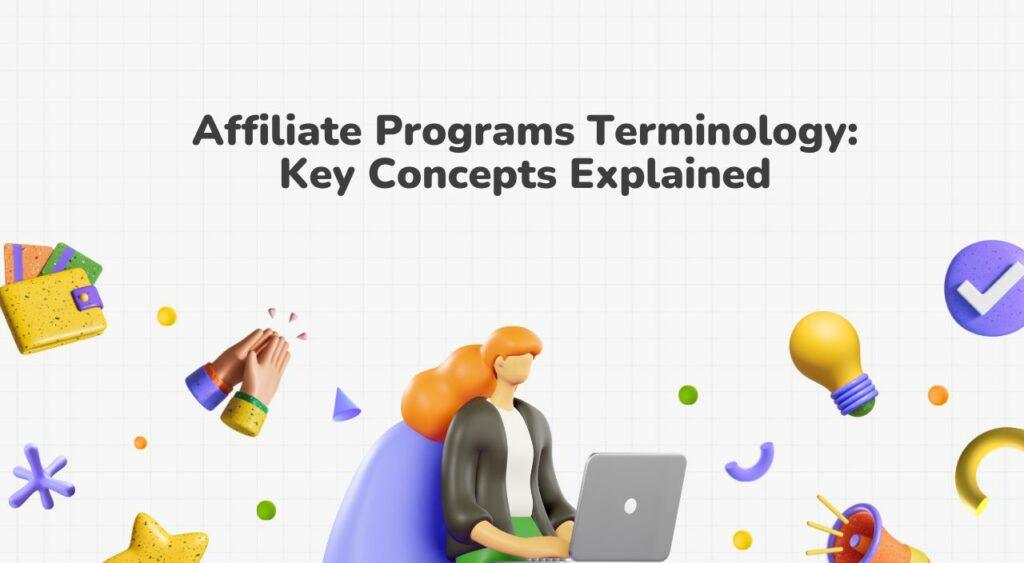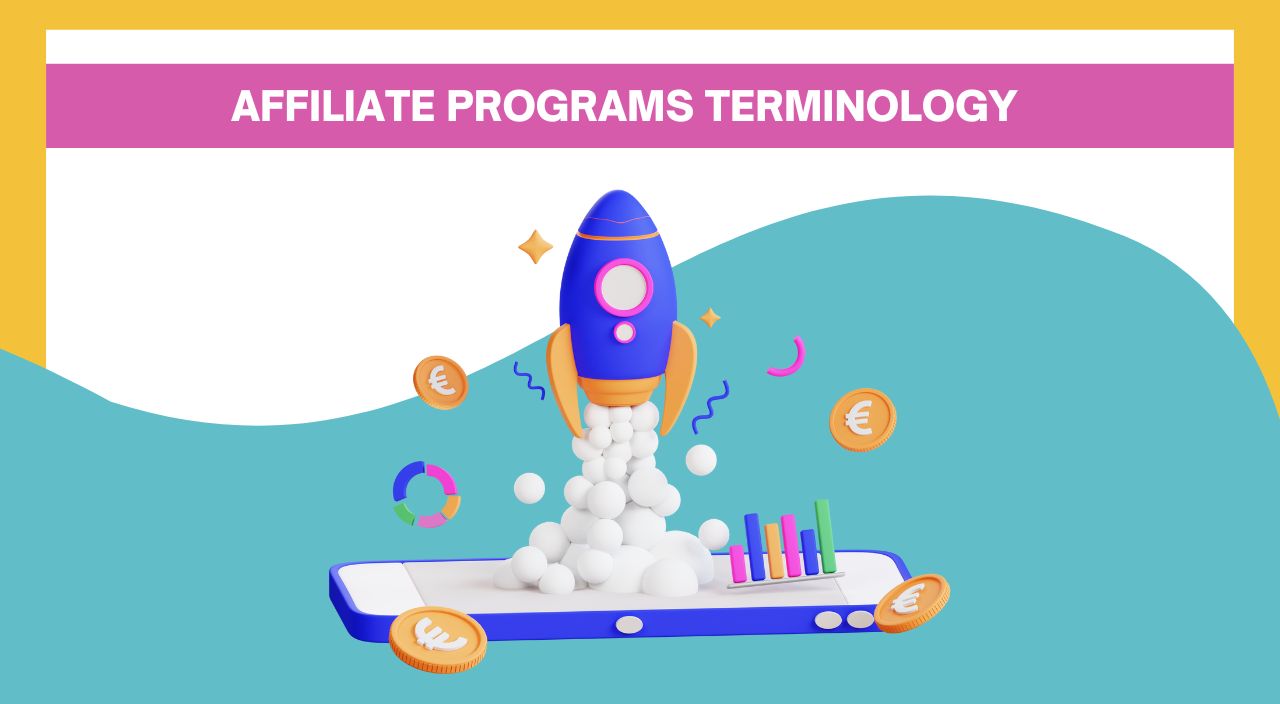What Is Affiliate Marketing
Affiliate marketing is when you help sell products for other companies online, and they pay you a commission. It is growing because it helps both businesses and individuals make money. Affiliate marketing works for various industries like fashion, technology, fitness, and more, making it accessible for almost anyone who wants to earn online.
Why Knowing Terms Is Important
Understanding these terms helps you work better with affiliate networks and get more sales. If you know the right terms, you can understand contracts, payments, and the best ways to get the most out of your affiliate efforts.
What You’ll Learn
This article will explain key affiliate marketing terms in a simple way with examples and guides. By the end, you’ll be ready to start promoting products and making commissions with confidence.
Foundational Affiliate Marketing Terms
Beginner-Level Terms
- Affiliate Network: A company that connects advertisers with people (affiliates) who promote their products. Examples include ClickBank, CJ Affiliate, and Rakuten Marketing.
- Affiliate Link: A special link used by affiliates to promote products. It tracks sales to make sure affiliates get paid. Every affiliate link is unique and ensures the correct affiliate gets credit for a sale.
- Affiliate Program: The system or company that allows affiliates to earn by promoting their products. Examples include Amazon’s affiliate program, where you get paid a small commission for every product sold through your link.
- Conversion: When someone completes an action like buying a product or signing up for a service. This means your affiliate link worked! High conversions usually mean more commissions.
- Click-Through Rate (CTR): The percentage of people who click your link after seeing it. A high CTR means your content is attracting attention and engaging your audience.
Intermediate-Level Terms
- Cost Per Action (CPA): How much you earn when someone does a specific action, like signing up or buying. CPA offers are popular because they are clear and easy to understand—you’re paid when someone takes an action.
- Cost Per Click (CPC): The amount paid each time someone clicks on an ad. This is important because it affects your advertising budget and how much you can earn in return.
- Commission Structure: How affiliates are paid, such as a fixed fee or a percentage of sales. Some programs offer flat fees, while others provide tiered commissions where you earn more the more you sell.
- Tracking Pixel: A small piece of code that helps track who visits a page after clicking an affiliate link. Tracking pixels are essential for ensuring you get paid for the conversions you drive.
Advanced-Level Terms
- Attribution Models: Ways to decide which affiliate gets credit for a sale, like first-click or last-click. This is important when multiple affiliates promote the same product, and it affects who gets paid.
- Dynamic Linking: Links that change based on the user, like showing products available in their country. This makes the shopping experience more personalized and can improve conversion rates.
- Sub-Affiliates: Affiliates who work under another affiliate. They earn a share of the original affiliate’s commission. Sub-affiliate programs can help affiliates build a team and earn passively.
- Lifetime Value (LTV): The total amount a customer might spend with a company over time. Affiliates focus on promoting products with high LTV because they can bring in more commissions over the long term.

Comparison Tables for Key Metrics
Comparing Payment Models
| Model | What It Means | When to Use It |
|---|---|---|
| CPA | Payment for a specific action | Good for clear actions like sign-ups and form submissions |
| CPL | Payment for each lead | Great for growing a contact list or generating interested users |
| CPS | Payment for sales | Best for high-value sales where the final purchase is needed |
PPC vs. CPM
| Model | Pros | Cons |
|---|---|---|
| PPC | Only pay for actual clicks | Can be costly per click, depending on competition |
| CPM | Lower cost for impressions | No guarantee of clicks; you’re paying for views regardless of actions |
Case Studies and Real-Life Applications
Dynamic Linking Example
Imagine you promote a shoe store. Dynamic linking changes the link to show the shoes available in a user’s country, which increases chances of sales. For example, if a user in Canada clicks the link, they will see options available to them locally, making them more likely to buy.
ROAS Example
Say you spend $20 on ads and make $100 in sales. Your Return on Ad Spend (ROAS) is 5x. This means you earned five times what you spent, which is a good return. A high ROAS means your advertising is working well.
Cookie Duration Impact
Affiliate A has a cookie duration of 30 days, while Affiliate B has 7 days. If a user clicks both links and buys after 15 days, Affiliate A gets the credit because their cookie lasts longer. Longer cookie durations give you more chances to earn a commission, even if the purchase happens days later.
Step-by-Step Guides or Tutorials
How to Create and Use Affiliate Tracking Links
- Join an Affiliate Program: Sign up for an affiliate network like ClickBank, Awin, or ShareASale. Each platform will have different kinds of products to promote.
- Get Your Link: Find the product you want to promote and get the affiliate link. Look for products that fit your audience.
- Share the Link: Post your link on social media, blogs, or ads. Make sure it is placed where your audience can easily find it.
- Track Conversions: Use the program’s dashboard to see how many clicks and sales you get. Tracking helps you see which products work best.
Optimizing Landing Pages for Higher Conversions
- Keep It Simple: Make sure the page has only one clear action to take. Remove distractions and focus on what you want users to do.
- Add Strong Calls to Action (CTAs): Use phrases like “Buy Now,” “Sign Up Today,” or “Learn More” to guide visitors to take action.
- Show Social Proof: Add customer reviews or testimonials to build trust. People are more likely to buy if they see that others have had good experiences.
- Use Compelling Images: Good visuals make the page more appealing and can increase the chances of someone buying the product.
Integrating Affiliate Software Tools
- Tools to Use: Set up tools like Post Affiliate Pro, Voluum, or ClickMeter to help manage and track your affiliate links.
- How to Set It Up: Follow the software’s guide to connect your affiliate links and start tracking performance easily. Most software tools provide step-by-step instructions that are easy to follow.
Illustrations and Diagrams for Affiliate Marketing
The outlined diagrams are designed to break down the complexities of affiliate marketing into understandable visual representations. By simplifying processes and highlighting key metrics, they aim to enhance reader comprehension and engagement with the subject matter.
Emerging Trends in Affiliate Marketing
AI Tools
Affiliates now use AI tools to predict which products will sell best. AI helps make campaigns more successful by analyzing past data to recommend products to promote.
Influencer Affiliate Programs
Influencers on Instagram, YouTube, or TikTok are now partnering with affiliate programs to share products with their followers. They earn a commission each time their followers buy through their links. Influencer marketing adds a personal touch that works well for many brands.
Content Commerce
Blogs and online articles are adding links to products they mention, making it easier for readers to buy directly from the page. This makes the buying experience seamless and boosts sales.
FAQs and Common Pitfalls in Affiliate Marketing
FAQs
- What Is the Ideal Cookie Duration?A 30-day cookie is ideal because it gives more time for a user to return and buy. Some programs offer even longer cookie durations, which can be better.
- How to Avoid Click Fraud?Use reliable tracking tools like ClickMeter and monitor your traffic to spot unusual patterns, like too many clicks without conversions. Avoiding low-quality traffic sources can also help.
Common Mistakes
- Overlooking Cookie PoliciesMake sure you understand how long your cookies last, or you could lose sales. Cookie policies vary by affiliate program, and knowing this can help you pick the right program.
- Improper Use of Tracking PixelsIncorrect placement means you won’t be able to track sales, losing out on commissions. Make sure the pixel is placed correctly, usually on the thank-you or confirmation page.
- Ignoring Audience FitPromoting products that do not match your audience’s interest will lead to low conversion rates. Always choose products that fit what your audience needs.
Practical Tools for Affiliates
Tracking Tools
Use Voluum, ClickMeter, and Post Affiliate Pro to see which links are working best. These tools help track clicks, conversions, and give insight into which campaigns perform well.
SEO Tools
Use Ahrefs, SEMrush, or Moz to find good keywords that will make your content show up in searches. This helps more people find your content and click your affiliate links.
Email Marketing Tools
Use tools like MailChimp or Aweber to create email campaigns that promote affiliate products. Sending emails can help increase clicks and conversions.
Interactive Quizzes to Test Knowledge
Quiz: Test Your Knowledge
Question: What’s the difference between CPC and CPM? Which is better for a new affiliate?
Answer: CPC (Cost Per Click) means you pay for each click on your ad, while CPM (Cost Per Mille) means you pay for every thousand views of your ad. CPC is better for beginners because you only pay when someone clicks.
Scenario Quiz
Question: If you have $50 to spend on ads, should you choose PPC or CPM? Why?
Answer: Choose PPC (Pay Per Click) if you want guaranteed clicks. With a limited budget, PPC ensures you pay only when someone interacts with your ad.
Interactive Scenario
Question: Imagine you’re promoting a fitness product. Should you use dynamic linking or a standard affiliate link if your audience is global?
Answer: Dynamic linking is better because it adjusts to the user’s location, showing them products available in their country.
Conclusion
Recap
Understanding affiliate terms like CPA, CTR, and ROAS will help you succeed in affiliate marketing. These terms are the foundation of how you earn commissions and improve your campaigns.
Learn More
Keep reading guides, glossaries, and watching tutorials to grow your knowledge. Practice what you learn to get better over time.
Ready to take your affiliate marketing skills to the next level? Join the Wealthy Affiliate Program—a comprehensive platform offering in-depth training on content marketing, YouTube marketing, PPC, and more. You’ll gain access to a supportive community of fellow marketers and direct guidance from the program’s founders. The entire community, including the owners, are ready to help you succeed. Whether you’re just starting or looking to scale your efforts, Wealthy Affiliate provides the tools and support you need to achieve your goals. Don’t miss this opportunity to learn from experts and connect with a community that’s eager to help you thrive in affiliate marketing!

